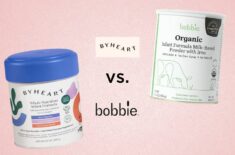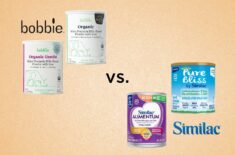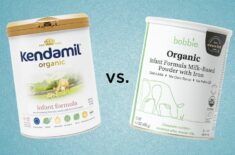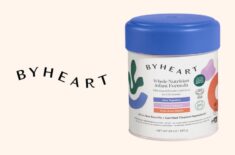Overview
Soy formulas are among the most common forms of dairy-free options available for your baby. But if you need or want to avoid giving soy to your child, you can also find formulas that are both dairy-free and soy-free.
There are many reasons why you might want or need to pick a non-dairy formula for your baby. Some of these are: (1)
- Cow’s milk protein allergy
- Lactose intolerance
- Higher risk of spit-up, fussiness, and reflux
- Malabsorption (difficulty in absorbing nutrients)
- Protein maldigestion (difficulty in digesting proteins)
- Ethical concerns with dairy formulas
- Interest in a plant-based diet for your baby
But you might also need a soy-free formula for these reasons:
- Soy allergies
- Congenital hypothyroidism because soy may interfere with the treatment (2)
- Concern about phytoestrogens in soy-based formulas, which are believed to affect your baby’s immune function. Phytoestrogens are compounds in plants that mimic estrogen. They might also affect thyroid function, neurobehavioral development, sexual development, and reproductive function. (3)(4)
Traditional formulas have dairy proteins in their full size. But these proteins can trigger an allergic reaction in your baby.
In non-dairy formulas, these proteins have been broken down into smaller pieces that may no longer cause allergies.
Partially hydrolyzed proteins have partially broken down proteins and may be ideal if your baby has spit-up, reflux, and gassiness.
What Formula Is Best For Milk And Soy Allergy?
Fully hydrolyzed proteins have fully broken down proteins that make these ideal if your baby has a dairy protein intolerance or dairy allergies.
For babies with severe allergies and dietary restrictions, amino acid-based formulas might be necessary. The proteins in these hypoallergenic formulas are further broken down into their most basic building blocks, amino acids.
Soy And Dairy-Free Formulas
Is There A Baby Formula Without Soy?
Here are some formulas that you can choose for your little one:
Else Plant-Based Complete Nutrition for Toddlers 



- It’s an organic, non-GMO plant-based formula.
- It contains nearly twice the FDA minimum requirement for iron.
Neocate Infant DHA/ARA (Hypoallergenic)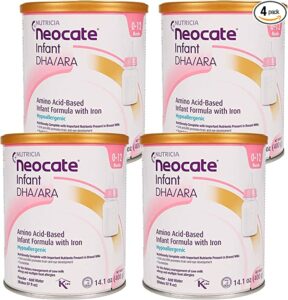


- It’s an amino acid-based formula with nucleotides, which can support growth and a healthier immune system for your baby.
- It also has DHA (docosahexaenoic acid), which are fatty acids that can help promote eye and brain development. (5)
- It also features ARA (arachidonic acid), which may support brain development, infant growth, and health. (6)
Baby’s Only Organic Pea Protein Formula


- It’s a value-friendly, organic formula that costs
- It may be the only pea formula currently available.
Formulas With Soy Oil, But May Be Free From Soy Proteins
Highly refined soybean or soy oil isn’t listed as an allergen on most food products because they may only have extremely low levels of allergenic soy proteins. Studies have shown that they may be eaten by food allergic individuals. (7)
The following are dairy-free products that are free from soy proteins but have soy oil: (7)
Enfamil Nutramigen Hypoallergenic Colic Baby Formula 




- Enfamil claims that this formula is clinically proven to reduce colic within 48 hours.
PurAmino Hypoallergenic Infant Formula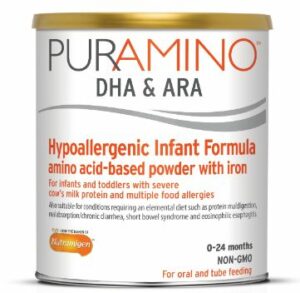




- It’s an iron-fortified, amino acid-based formula.
- It also contains DHA and ARA.
Nestlé Alfamino Infant Formula 


- It has higher calcium levels which can help support your baby’s bone development.
Similac Alimentum 


- Similac claims that this formula is clinically proven to reduce crying due to milk protein sensitivity within 24 hours.
Similac Elecare 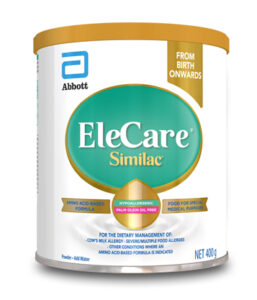
- It’s an amino acid-based formula with prebiotics.
Learn more about each soy and dairy-free formula below.
Else Plant-Based Complete Nutrition for Toddlers



Best Features & Safety
- It’s an organic, non-GMO plant-based formula.
- It contains 4 mg of iron per 180 calories (or 2.22 mg per 100 calories), which is twice the FDA minimum of 1 mg of iron per 100 calories. (8)
- This formula goes through minimal processing without hexane (a toxic chemical), solvent extraction methods, or other forms of chemical processing.
- It doesn’t have highly processed ingredients.
Ingredients
- Organic almond butter
- Organic buckwheat flour
- Organic tapioca maltodextrin
Nutritional Facts
Each serving (4 fl oz of water) contains the following:
- Calories: 180 calories
- Total fats: 9 g
- Protein: 5 g
- Total carbohydrates: 19 g
- Added sugars: 2 g
- Dietary fibers: 2 g
- Vitamin A: 145 mcg
- Vitamin C: 4 mg
- Choline: 40 mg
- Iron: 4 mg
- Calcium: 220 mg
Product Recall
- None
Pros & Cons
Pros
- It doesn’t have corn syrup or other processed sweeteners.
- It’s a plant-based formula that may be suitable for vegan and vegetarian diets.
- It’s sustainably made and formulated.
- It can help provide your child with whole food nutrients.
Cons
- The company declares that it can’t be used as the only source of nutrition for babies. Instead, you can combine this formula with breast milk, another formula, or solid foods.
- It has tree nuts (almonds) and may not be ideal if your kid has a nut allergy.
- The formula may be prone to clumping.
- It’s formulated for kids 12 months and older.
- It contains maltodextrin and added sugars.
What Customers Say
Positive Reviews
“My 16 month old toddler loves it! Great ingredients and doesn’t have a bunch of sugar like other formulas.” – Reviewer on Else Nutrition’s website.
Negative Reviews
“This is a great product, but my toddler does not like it and refuses to drink, even with modifications to the flavor.” – Reviewer on Else Nutrition’s website.
Neocate Infant DHA/ARA (Hypoallergenic)


Best Features & Safety
- It’s an amino acid-based formula.
- It has added nucleotides, which may support growth and a healthier immune system in formula-fed infants.
- It also contains DHA (docosahexaenoic acid), an omega-3 fatty acid that can help support your child’s proper brain development.
- This formula also has ARA (arachidonic acid), an omega-6 fatty acid that may support brain development, infant growth, and health.
Ingredients
- Corn syrup solids
- MCT oil (medium-chain triglycerides)
- High oleic sunflower oil
- Sunflower oil
- Canola oil
- Amino acids
- Mortierella alpina oil (source of ARA)
- Crypthecodinium cohnii oil (source of DHA)
- Taurine
- Nucleotides
Nutritional Facts
Each 5 fl oz serving of this formula contains:
- Calories: 100 kcal
- Total fats: 5.1 g
- Protein: 2.8 g
- Total carbohydrates: 10.8 g
- Iron: 1.5 mg
- Calcium: 116 mg
- Linoleic acid: 738 mg
- Vitamin C: 10.7 mg
- Potassium: 109 mg
- Iodine: 20.7 mg
Product Recall
In 2009, Nutricia North America recalled the Neocate Infant Specialized formula due to a blending error that made one batch/lot have lower protein content. (9)
The minimum requirement for protein content in US infant formulas is 1.8 g per 100 kcal; Neocate usually has 2.8 g (as listed on their website and the formula can). (8)
But the blending error caused the formula to have a reduced protein content of 1.75 g protein per 100 kcal. (9)
The recall affected only one lot, #P91877, of the formula (14.1 oz can). No other products were included. (9)
According to the recall advisory, short-term consumption of the affected product is unlikely to cause nutritional issues. But continued, longer-term consumption may affect your baby’s growth. (9)
If you have purchased a recalled formula, you can contact Nutricia North America through 800-365-7354, option 8-6061, for replacement or refund. (9)
Pros & Cons
Pros
- It’s made in a dairy protein-free facility.
- It’s also free from soy oil. While highly refined soy oil doesn’t contain soy proteins which can trigger allergic reactions, you might prefer to keep this processed oil from your baby’s diet. (7)
- It’s free from artificial colors, flavors, sweeteners, or potential allergens.
- It’s halal and Kosher certified.
- It can provide complete nutrition for babies with certain dietary restrictions during their first year. But make sure to consult with your healthcare provider before giving this or any formula to your child.
Cons
- It contains corn syrup and highly processed vegetable oils such as canola oil.
- It may be more difficult to dissolve than regular formula options.
- Prolonged use of Neocate formula may cause rickets (soft, weak bones) and GERD (gastroesophageal reflux disease), particularly if your child doesn’t receive calcium from other food sources or through supplementation. (10)(11)(12)
- It can cost several times more than most dairy formulas.
- It may make your baby’s poop turn green. But Neocate claims that this is normal because that’s how the human body digests and processes amino acids.
- It had a recall in 2009. (9)
What Customers Say
Positive Reviews
“Neocate helped with my daughter acid reflux. I would reccomend it to any mom with a baby that has colic or acid reflux.” – Reviewer on Neocate’s website.
Negative Reviews
“My only complaint is the cost, I wish it was cheaper because it is the only thing that works for my son, but you have to do what you have to do!” – Reviewer on Amazon.
Enfamil Nutramigen with Enflora LGG Hypoallergenic Infant Formula




Best Features & Safety
- According to Enfamil’s website, Enfamil Nutramigen is clinically proven to reduce colic due to cow’s milk allergy within 48 hours.
- The brand also claims that it may help reduce the incidence of future allergies (including asthma, eczema, urticaria, and rhinoconjunctivitis).
- It’s a hypoallergenic formula.
- It contains LGG (Lactobacillus rhamnosus GG) probiotic cultures, a gut-friendly bacteria for your baby’s healthier digestive system.
- It has DHA to support your baby’s brain development.
Ingredients
- Corn syrup solids
- Vegetable oil (high oleic sunflower, coconut, soy, or palm olein oil)
- Modified casein hydrolysate
- Modified corn starch
- Mortierella alpina oil (for ARA)
- Schizochytrium sp. oil (for DHA)
- Lactobacillus rhamnosus (probiotics)
Nutrition Facts
Each serving (5 fl oz) of this formula contains:
- Calories: 100 calories
- Total fats: 5.3 g
- Protein: 2.8 g
- Total carbohydrates: 10.3 g
- Vitamin E: 2 IU
- Iron: 1.8 mg
- Calcium: 94 mg
- Choline: 24 mg
- Iodine: 15 mcg
Product Recall
Mead Johnson Nutritionals recalled Nutramigen due to incorrect, potentially dangerous preparation instructions in 2001. (14)
According to the advisory, these incorrect instructions (written in Spanish) may inadvertently lead to serious health issues and possible death. (14)
These lot codes of the powder infant formula (16-ounce) were recalled: (14)
- BHC43
- BHC44
- BJC45
- BJC46
- BJC47
- BJC48
- BKC49
- BKC50
- BLC51
- BLC52
- BLC53
- BMC54
- BMC55
- BMC56
- BAM57
- BAM58
- BBM59
- BBM60
- BBM61
- BCM62
- BCM63
- BCM64
- BDM65
- BDM66
- BEM67
- BEM68
- BEM69
- BEM70
- BEM71
- BEM72
- BFM73
- BFM74
These lot codes of the ready-to-use (32-ounce) liquid formula were included: (14)
- MBM90
- MBM91
- MCM92
- MCM93
- MCM94
- MDM95
- MDM96
- MEM97
- MFM00
- MFM01
Pros & Cons
Pros
- It doesn’t have artificial growth hormones.
- It’s lactose-free.
- It doesn’t contain table sugars or sucrose.
Cons
- It contains palm olein oil.
- It had a recall. (14)
- It can be more expensive than regular formulas.
Is Nutramigen Dairy And Soy Free?
Although Nutramigen comes from dairy sources, its milk proteins are already broken down so they are less likely to cause an allergic reaction. It has soy oil, which is highly processed so it may no longer be allergenic.
What Customers Say
Positive Reviews
“At 5 months, our little boy started to develop a rash all over his front and back and was screaming all night long when we started supplementing with a different formula. The doctor suggested trying Nutramigen. Literally that night, he slept 8 hours straight without screaming and his rash started to disappear.” – Reviewer on Enfamil’s website.
Negative Reviews
“This product was chosen for us by the NICU pediatrician for food sensitivities because my newborn might have the same food allergies that I have (I have 15). From the beginning of bringing him home however, we had to endure 1-2 hours of gas, stomach pain and crying.” – Reviewer on Enfamil’s website.
PurAmino Hypoallergenic Infant Formula




Best Features & Safety
- It’s a hypoallergenic, amino acid-based formula.
- It contains DHA & ARA.
- It’s iron-fortified.
Ingredients
- Corn syrup solids
- Amino acids
- High oleic sunflower oil
- Medium-chain triglyceride oil
- Soy oil
- Modified tapioca starch
- Mortierella alpina oil
- Schizochytrium sp. oil
- Taurine
Nutrition Facts
Each serving (5 fl oz) of this formula contains:
- Calories: 100 calories
- Total fats: 5.3 g
- Protein: 2.8 g
- Total carbohydrates: 10.6 g
- Iron: 1.8 mg
- Calcium: 116 mg
- Linoleic acid: 860 mg
- Vitamin C: 12 mg
- Potassium: 110 mg
- Iodine: 15 mcg
Product Recall
- None
Pros & Cons
Pros
- It can be the sole nutrition source for your baby up to six months old.
- It may be used as a milk substitute for children up to 24 months old if medically indicated. Always check with your pediatrician or healthcare provider before switching or starting formulas.
Cons
- It contains corn syrup solids and highly processed vegetable oils.
- It has soy oil.
- It may have a strong scent that’s different from other formula options.
- It’s several times more expensive than regular formulas.
- It may cause poop discoloration.
What Customers Say
Positive Reviews
“This is by far the least offensive smelling and tasting one, I actually don’t notice a smell at all. My baby is tolerating it well so far which is the most important part. No more blood in her stools!” – Reviewer on Enfamil’s website.
Negative Reviews
“This product is terrible. It smelled like Clorox. bleach. Whatever you do, never ever give this product to your child or use for any sort of human consumption.” – Reviewer on Amazon.
Baby’s Only Organic Pea Protein Formula


Best Features & Safety
- It’s a toddler formula made from non-GMO ingredients (no genetically modified organisms).
- It may be the only pea-sourced formula currently available on the market.
- It’s a plant-based formula that can be suitable for vegetarian and Kosher diets.
- It has essential fatty acids that can promote brain and eye development.
Ingredients
- Organic pea protein concentrate
- Organic brown rice syrup
- Organic high oleic oil (sunflower or safflower)
- Organic canola oil
- Organic linoleic sunflower oil
- Organic coconut oil
- Organic sunflower lecithin
Nutrition Facts
Each serving (4 fl oz) of this formula contains:
- Calories: 80 calories
- Total fats: 4 g
- Protein: 2 g
- Total carbohydrates: 9 g
- Vitamin A: 70 mcg
- Vitamin D: 1.3 mcg
- Vitamin K: 7 mcg
- Choline: 10 mg
- Vitamin E: 1.1 mg
- Iron: 1.4 mg
- Calcium: 90 mg
- Potassium: 110 mg
Product Recall
- None
Pros & Cons
Pros
- It’s OU (Orthodox Union) certified Kosher.
- It’s a non-GMO toddler formula.
- It’s made with ingredients grown without pesticides, insecticides, or weed-killer glyphosate.
- It doesn’t have corn syrups.
- It doesn’t contain palm olein oil or palm oil.
Cons
- It’s only for kids above 12 months of age.
- According to Nature’s One, it meets the guidelines for baby formula composition by the U.S. Infant Formula Act and the AAP (American Academy of Pediatrics). But this kind of formula (pea protein-based) hasn’t been approved for commercial use yet.
- It contains brown rice syrup, a processed sweetener.
- It has highly processed vegetable oils, including canola oil.
What Customers Say
Positive Reviews
“My son doesn’t tolerate dairy as well as my daughter does, so I have to purchase the pea protein formula for him. Fortunately for me, Baby’s Only offers me that option.’” – Reviewer on Nature’s One.
Negative Reviews
“My baby didn’t do well he had a skin reaction.” – Reviewer on Nature’s One.
Nestle Alfamino Infant Formula


Best Features & Safety
- It’s an amino acid-based formula for your baby’s first year.
- It’s hypoallergenic.
- It contains a unique fat blend with MCT (medium-chain triglycerides) that may help children with fat malabsorption.
- It has linoleic acid to support a healthy heart.
- It’s lactose-free and gluten-free.
Ingredients
- Medium chain triglycerides
- Corn syrup solids
- Vegetable oils (high-2 palmitic vegetable, soybean, or high oleic sunflower oils)
- Potato starch
- Crypthecodinium cohnii oil (source of DHA)
- Mortierella alpina oil (source of ARA)
- Choline bitartrate
Nutritional Facts
Each serving (5 fl oz) of this formula contains the following:
- Calories: 100 calories
- Total fats: 5 g
- Protein: 2.8g
- Total carbohydrates: 11 g
- Linoleic acid: 696 mg
- Vitamin A: 315 IU
- Vitamin C: 15 mg
- Choline: 24 mg
- Iron: 1.8 mg
- Calcium: 119 mg
Product Recall
Nestle recalled Alfamino Amino Acid Infant Formula in Germany in December 2018 due to a formulation error that can make your child sick. (13)
The blend contains higher levels of minerals, which can cause nausea, vomiting, and headaches. (13)
If your child experiences these symptoms after drinking the formula, Nestle Germany recommends that you immediately call your pediatrician or bring the affected kid to the hospital. (13)
Only lot/batch number 80250346GA (14.1 oz can) was affected by the recall. (13)
According to the recall advisory, the faulty blend may cause your baby’s formula to look green or grey. (13)
Pros & Cons
Pros
- It may be easy to digest.
- It’s lactose-free and gluten-free.
Cons
- It contains corn syrup and vegetable oils.
- It was recalled in 2018 due to a faulty formulation. It has been resolved and only involved one batch. (13)
- It can cost much more than regular formulas.
- You shouldn’t choose this formula if your baby has galactosemia (problems with digesting galactosemia, another sugar in dairy products).
- Only use with medical supervision.
What Customers Say
Positive Reviews
“My daughter requires this formula for a deficiency her body has. She seems to like the taste and is always happy to get this. The smell is not too bad in my opinion.” – Reviewer on Amazon.
Negative Reviews
“It gave my baby a horrible reaction he was extremely fussy and gassy.” – Reviewer on Amazon.
Similac Alimentum Hypoallergenic Formula
Best Features & Safety
- It’s based on casein hydrolysate from milk sources.
- It’s hypoallergenic. (16)
- It contains shorter fats called MCT (medium-chain triglycerides) that may be easier for your baby’s digestive system to absorb.
Ingredients
- Corn maltodextrin
- Casein hydrolysate
- Sugar
- High oleic safflower oil
- Soy oil
- Medium-chain triglycerides
- Crypthecodinium cohnii oil (for DHA)
- Mortierella alpina oil (for ARA)
Nutrition Facts
Each 5 fl oz serving of this formula contains:
- Calories: 100 calories
- Total fats: 5.54 g
- Protein: 2.75 g
- Total carbohydrates: 10.2 g
- Vitamin A: 300 IU
- Vitamin C: 9 mg
- Iron: 1.8 mg
- Calcium: 105 mg
Product Recall
There hasn’t been any recall on the powder form of Similac Alimentum.
The liquid, ready-to-drink Similac Alimentum formula (32 oz bottles) was recalled in September 2006 due to a manufacturing defect. (17)
The bottle doesn’t have a special layer that’s supposed to keep the air out. When air enters the bottle, oxygen may react with the vitamin C content, causing it to decrease over time. (17)
While the formula may still be safe for consumption, the lower vitamin C levels can lead to a nutrient deficiency. (17)
According to the recall advisory, babies who drink any formula with low levels of this vitamin for two to four weeks might begin showing these signs of vitamin C deficiency: (17)
- Irritability with generalized tenderness
- Easy bruising
- Paleness
- Fatigue
The recalled Similac Alimentum formulas have the following details printed on the back of the bottles: (17)(18)
- Lot 401895V
- Use-by date code of “1 May 2007”
- Stock code 57512.
These products have been distributed by Abbott Nutrition’s Ross Products division to retailers across the United States, Guam, and Puerto Rico between May 18 and September 5, 2006. (18)
If you bought this product or received them as a sample from the hospital or your baby’s pediatrician, you may get free replacements from Ross Products Division by calling them at 800-624- 3412. (18)
There were no medical complaints reported concerning this recall. (18)
Pros & Cons
Pros
- It’s a hypoallergenic formula.
- It doesn’t have palm olein oil, a component in some formulas that can affect calcium absorption. (19)
Cons
- It contains added sugars, corn maltodextrin, and highly processed vegetable oils.
- You are required to store it in cool temperatures once the container is opened.
- It has soy oil.
Is Similac Alimentum Milk Based?
It’s based on milk, but its milk proteins have already been broken down into smaller pieces that may no longer be allergenic.
What Customers Say
Positive Reviews
“This formula truly made a huge difference. My baby tried about 2 formulas before the Alimentum. He was colicky and fuzzy.” – Reviewer on Similac’s website.
Negative Reviews
“His gas has continued and has in fact worsened. This formula is so thin, so when he was eating, he was eating every 1.5-2 hours when before he was eating every 3 hours.” – Reviewer on Similac’s website.
Similac EleCare
Best Features & Safety
- It’s an amino-acid-based infant formula made for special medical purposes.
- It has 2’-FL (2’-fucosyllactose), a human milk oligosaccharide (HMO). These HMOs are prebiotics (bioactive carbohydrates) abundant in breast milk and may promote a healthier immune system.
- It contains ARA and DHA, essential fatty acids that can promote better brain development.
- It’s hypoallergenic.
Ingredients
- Corn syrup solids
- Amino acids
- Vegetable oils (MCT oil from palm kernel oil and coconut oil, high oleic safflower oil, and soy oil)
- ARA from M. alpine oil
- DHA from C. cohnii oil
- 2’-fucosyllactose (derived from lactose)
- Emulsifier: E1450 (modified starch)
Nutritional Facts
Every serving (5 fl oz) of this formula preparation contains:
- Calories: 100 calories
- Total fats: 4.8 g
- Total carbohydrates: 10.7 g
- Proteins: 3.1 g
- Vitamin A: 273 IU
- Vitamin C: 9 mg
- Iron: 1.8 mg
- Calcium: 116 mg
- Iodine: 8.9 mcg
- Potassium: 150 mg
Product Recall
- None
Pros & Cons
Pros
- It’s formulated for babies from birth to 12 months old.
- It may be suitable for vegetarians.
Cons
- It can cost more than regular cow’s milk formula.
- It has corn syrup and vegetable oils.
- It contains maltodextrin. Though it’s not listed on its ingredients, maltodextrin was identified as a carbohydrate source in Elecare’s datasheet posted by its parent company Abbott Nutrition. (15)
- It may have a strong scent and cause your child’s stool to be discolored.
What Customers Say
Positive Reviews
“My son is anaphylactic to milk and this is the only formula he’s tolerated.” – Reviewer on Walmart.
Negative Reviews
“Loose stools. Smells awful! Expensive!” – Reviewer on Amazon.
Summary And Recommendations
You can choose the following soy-free, non-dairy formulas, depending on your baby’s needs or your preference:
- Baby’s Only Organic Pea Protein Formula – if you want a value-friendly, organic formula made from pea proteins.
- Else Plant-Based Complete Nutrition for Toddlers – if you prefer an organic, non-GMO plant-based formula with nearly twice the FDA minimum requirement for iron.
- Neocate Infant DHA/ARA – if you want an amino acid-based formula with nucleotides, DHA, and ARA.
- Nestlé Alfamino Infant Formula – if you’re looking for a formula with higher calcium levels.
- Enfamil Nutramigen Hypoallergenic Colic Baby Formula – if you prefer a clinically proven formula that may reduce colic within 48 hours.
These formulas are non-dairy and free from soy proteins, but they have soy oil: (7)
- PurAmino Hypoallergenic Infant Formula – if you prefer an iron-fortified, amino acid-based formula with DHA and ARA.
- Similac Elecare – if you prefer an amino acid-based formula with prebiotics.
- Similac Alimentum – if you want a clinically proven formula for reducing crying due to protein sensitivity within 24 hours.
Soy And Dairy-Free Formulas FAQs
Why Choose A Dairy-Free Formula?
Here are some reasons why you might need or want to choose dairy-free formulas for your baby: (1)
- Cow’s milk protein allergy
- Other allergies to cow milk and dairy components
- Lactose intolerance
- Lactose hypersensitivity
- Higher risk of spit-up, fussiness, and reflux
- Post-infectious diarrhea
- Galactosemia (problems with digesting galactose, another sugar in dairy products)
- Eosinophilic esophagitis (build-up of the white blood cell eosinophil in the esophagus)
- Short bowel syndrome (your baby has shorter small intestines, which may lead to problems with nutrient absorption)
- Malabsorption (difficulty in absorbing nutrients)
- Protein maldigestion (difficulty in digesting proteins)
- Ethical concerns with dairy formulas
- Interest in a plant-based diet for your baby
Why Choose A Soy-Free Formula?
Many dairy-free formulas are made from soy, but the following may be some of the reasons for picking soy-free options:
- Soy allergies
- Congenital hypothyroidism; soy may interfere with the treatment (2)
- Your child doesn’t like the taste of soy formula
- You’re concerned about phytoestrogens from soy-based formulas, which may have some effect on your child’s neurobehavioral development, sexual development, reproductive function, immune function, and thyroid function. (3)(4)
What’s The Difference Between Casein Hydrolysate And Amino Acid-Based Formulas?
The proteins in regular formulas are in their full size. They may be called different names but may be listed on the formula container as:
- Nonfat milk
- Milk protein isolate
- Whey protein
- Soy protein isolate (for soy formulas)
Standard cow’s milk protein formulas have intact proteins in their full size.
Hydrolyzed proteins are broken down into smaller pieces and may be listed as:
- Partially hydrolyzed nonfat milk
- Fully hydrolyzed protein formula
- Hydrolyzed proteins
- Casein hydrolysate
- Whey protein hydrolysate
Casein hydrolysate is made up of peptides from broken-down proteins. These peptides are short chains of amino acids, the building blocks of proteins.
- These smaller peptides may be easier to digest and less allergenic than the whole proteins from standard formulas.
- They may be more palatable than amino acid-based formulas.
Amino acid-based formulas are those made from free amino acids.
- These much smaller protein parts may be indicated for babies with severe symptoms of cow’s milk protein allergies and/or multiple food allergies.
- They might be hypoallergenic and the easiest to digest by sensitive tummies because of their much smaller size.
- The downside is that they might not taste or smell the same way as other infant formulas.
Are Soy Formulas Safe?
Soy formulas have been available for nearly 100 years. They may account for as much as 25% of the formula market in the US. (3)(4)
Despite the safety concerns listed above, study results are conflicting and may not conclusively indicate or confirm that soy formulas caused the health issues. (3)(4)
But always consult your child’s pediatrician before starting or switching to any formula.
Soy Formulas
The following are examples of soy milk formulas:
- Gerber Good Start Soy
- Enfamil ProSobee Soy-Based Infant Formula
- Similac Soy Isomil Infant Lactose-Free Formula
- Parent’s Choice Soy Infant Formula
REFERENCES
(1) https://pubmed.ncbi.nlm.nih.gov/24507712/
(2) https://www.ncbi.nlm.nih.gov/pmc/articles/PMC1755887/
(3) https://www.ncbi.nlm.nih.gov/pmc/articles/PMC6265372/
(4) https://pubmed.ncbi.nlm.nih.gov/9217716/
(5) https://pubmed.ncbi.nlm.nih.gov/10479465/
(6) https://www.ncbi.nlm.nih.gov/pmc/articles/PMC4848685/
(7) https://www.kidswithfoodallergies.org/soy-allergy.aspx
(8) https://www.accessdata.fda.gov/scripts/cdrh/cfdocs/cfcfr/cfrsearch.cfm?fr=107.100
(9) https://www.aappublications.org/content/early/2009/10/01/aapnews.20091001-1
(10) https://pubmed.ncbi.nlm.nih.gov/31143989/
(11) https://pubmed.ncbi.nlm.nih.gov/30314926/
(12) https://pubmed.ncbi.nlm.nih.gov/28167344/
(13) https://www.reuters.com/article/us-nestle-recall-idUKKBN1O50I2
(14) https://www.nytimes.com/2001/07/10/us/national-briefing-science-and-health-recall-of-baby-formula.html
(15) https://www.abbottnutrition.ie/downloads/10-EleCare-datasheet-HCP-version-3-Jan-020.pdf
(16) https://pubmed.ncbi.nlm.nih.gov/2007924/
(17) https://www.aappublications.org/content/27/9/2006229
(18) https://www.cbsnews.com/news/huge-recall-of-similac-baby-formula/
(19) https://pubmed.ncbi.nlm.nih.gov/8780336/



